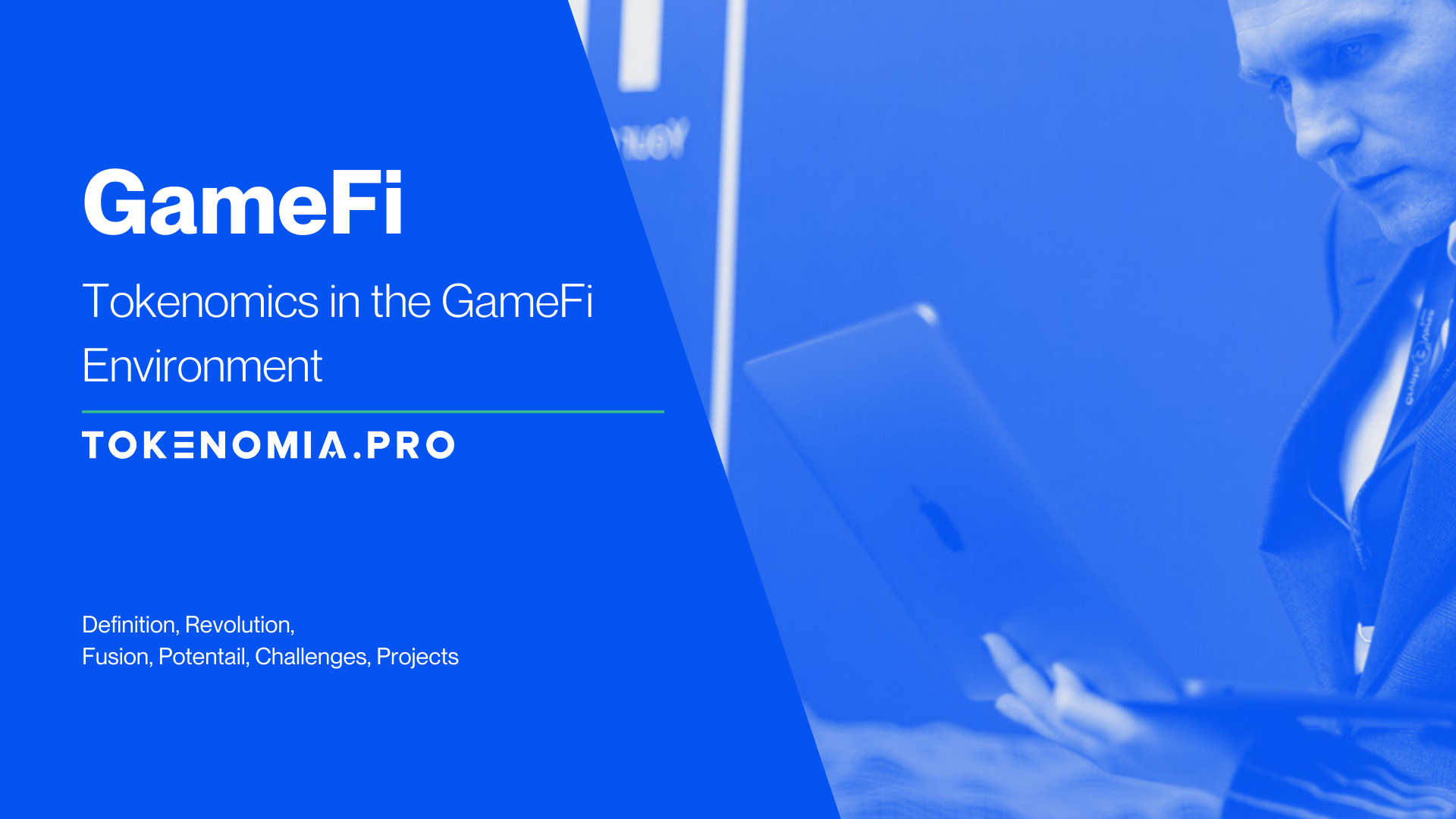 27 minutes read
27 minutes readTable of contents
DAO – Decentralized Autonomous Organization explained
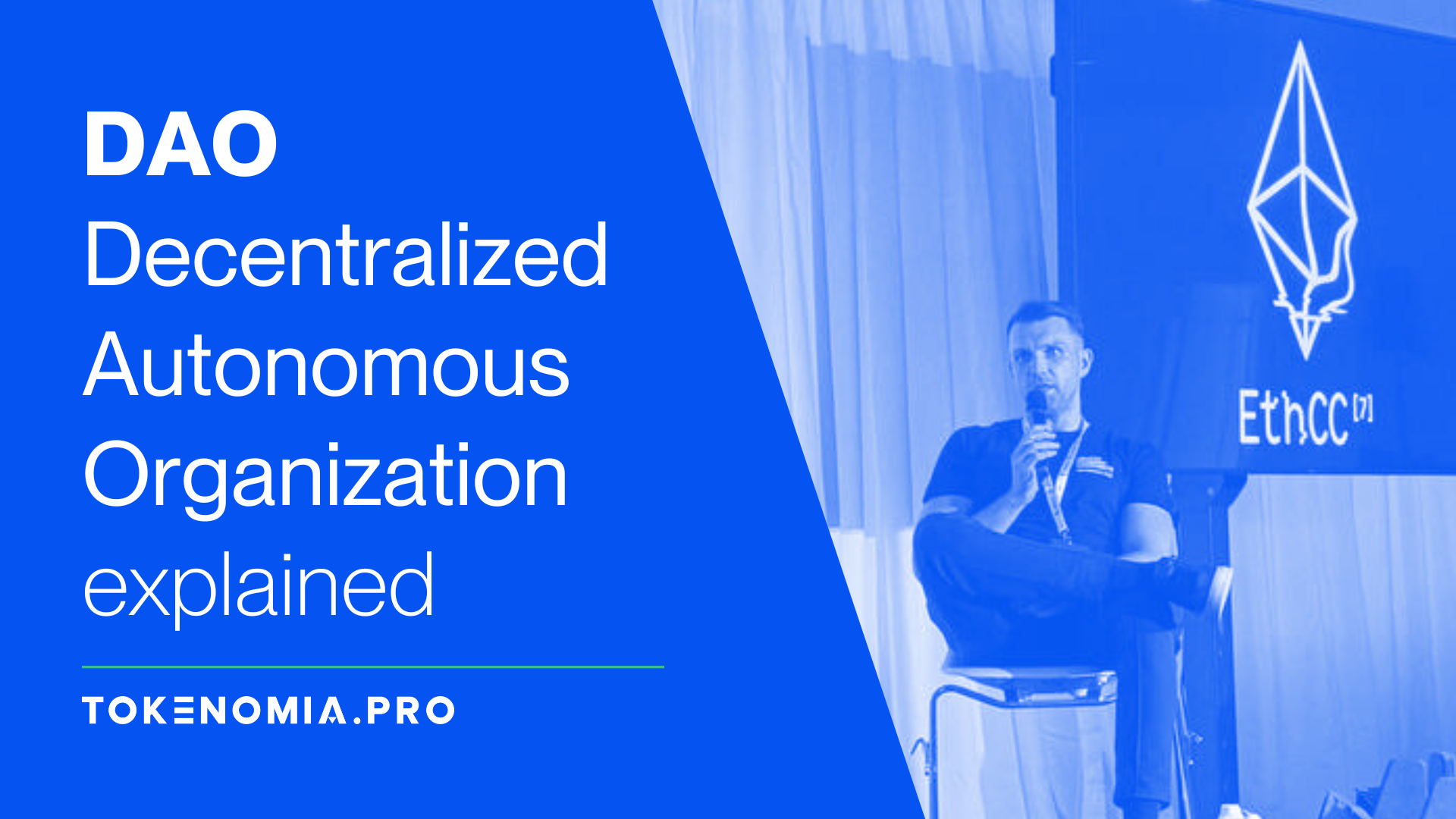
Rethinking Hierarchical Structures and Decentralized Decision-Making
Exploring the Need of DAOs
In the current world, the majority of organizations, foundations, corporations, and companies operate with a hierarchical structure. As a result, we have a rigid division between subordinates and superiors. This leads to inequalities in decision-making power. In an ideal world, the head of the organization should have the most holistic understanding of the company. It should be gathered from various departments so that decisions are made based on the well-being of the greater whole by all individual members. However, we know that in most cases, this is far from true.
Decisions are often made based on selective data, opinions, or self-interest. The main issue is that there are few decision-makers, but many people who possess valuable information and perspectives. This creates a difficulty because it is hard to consider all these opinions, especially when they stand in opposition to each other. Decisions are usually made at the highest levels of the hierarchy, often, unfortunately, based on a limited subset of all available information. Important information and opinions from lower-level employees are frequently overlooked. Despite individuals at lower levels of the hierarchy often having a better and deeper understanding of the specifics of the daily problems or challenges the company faces.
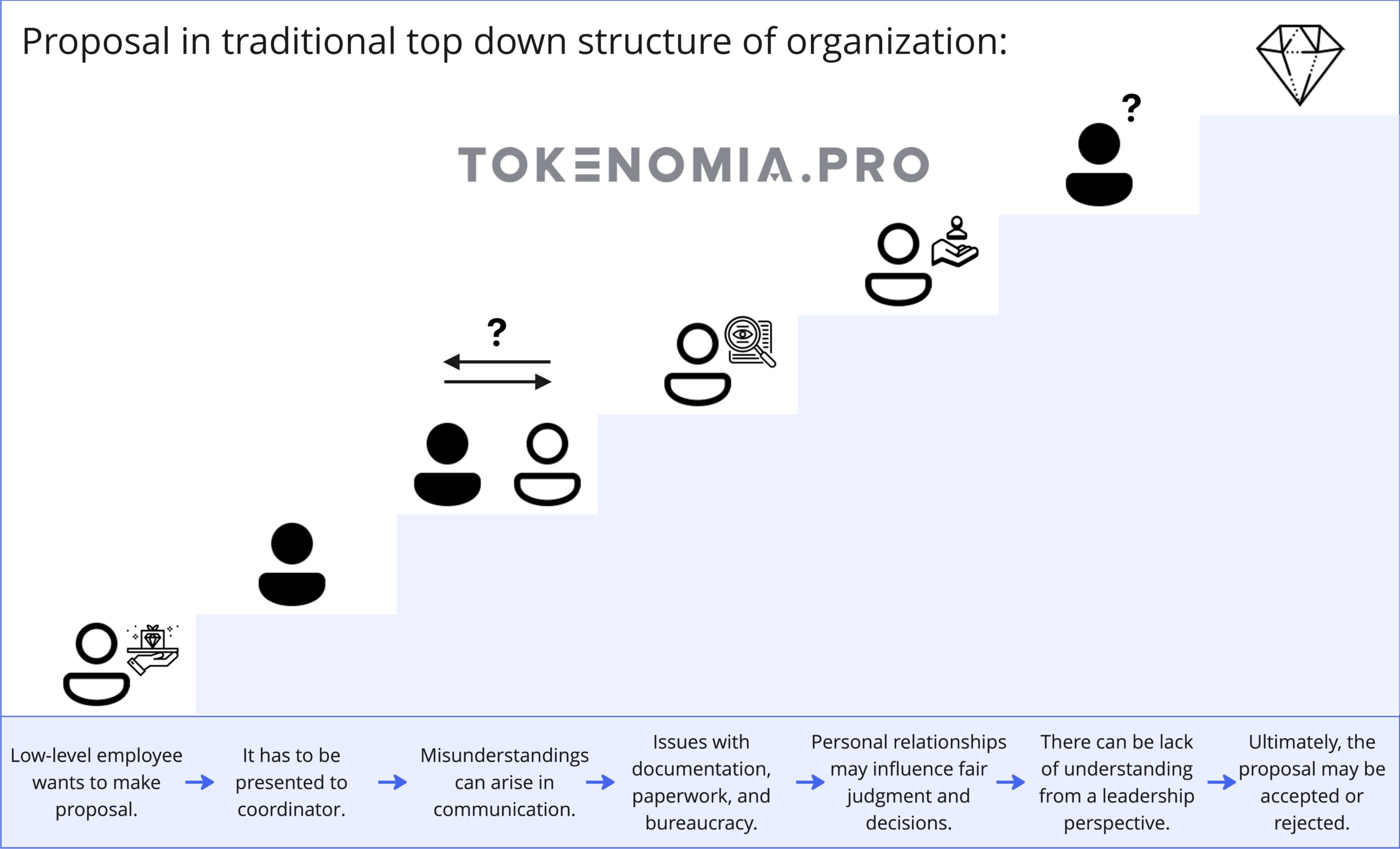
Challenges in Hierarchical Management
In a hierarchical management structure, if someone at the bottom wants to propose changes, they must navigate through a series of go-betweens, documents, requests, and so on. The journey to make a proposal is long and involves bureaucratic hurdles. Obstacles include difficult communication between people, teams, and managers as well. It’s not just about paperwork. It can also involve mental barriers and leadership misunderstandings. At each rung of the stairs, proposals may face rejection or get lost in the corporate maze. Questions also arise about the top decision-maker. Can this person understand the view of everyday users and problems they face? What improvements and flaws do they see? What can be optimized?
This raises even more questions. Should the power to decide depend on formal education, hard work, connections or even luck? Or should those most invested in the success of the company and project be the ones to decide, because they have invested more time or finances into it? Who would feel greater responsibility? Is the person at the top of the pyramid? They manage the resources of someone they have hired. If they fail, they risk not their own assets and can escape to another place. Or perhaps all individuals invested? For whom the success of the project is synonymous with personal success.
If these questions raise any doubts about current decision-making practices, we have good news. There is a concept that addresses these issues is known as the DAO, or Decentralized Autonomous Organization. While it may not solve all problems related to dividing power and responsibility or distributing agency, it successfully addresses many issues inherent in centralized solutions. This approach is markedly different from the traditional centralized leadership and comes with its own set of challenges.
But what exactly is a DAO?
In this article you will learn about:
- How does a DAO empower the community?
- What are the essential components of DAOs?
- What is the process of building a DAO?
- What are the biggest challenges of DAOs projects and how to address them?
Dive in to discover!
Empowering Communities
The Role and Impact of DAOs in Web3
Decentralised Autonomous Organisation or a DAO stands as a novel organizational structure in the emerging landscape of Web3. It is a structure without a central governing body. Members collectively participate in a decentralised decision-making process with the shared goal of acting in the project’s best interest. The basis for being authorized to vote is owning the project’s token. Often likened to a “crypto-cooperative” or “financial flash mob,” a DAO can be conceptualized as a community-driven entity without central authority.
DAOs are a fascinating concept, but they also come with their own set of challenges, some of which are even more significant than those faced by traditional organizational structures. These complexities will be explored further in the later sections of this article.
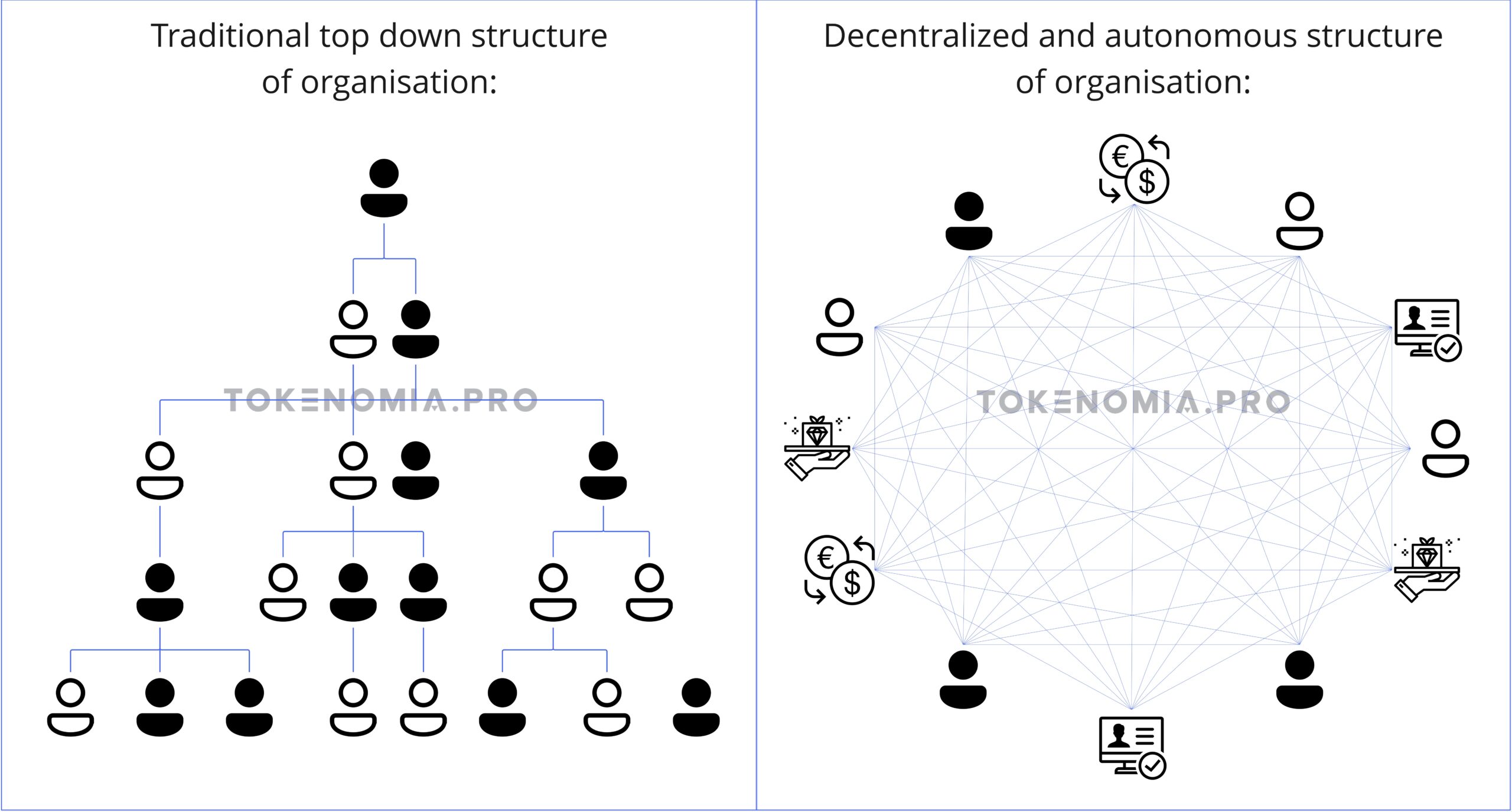
- Decentralized – Refers to the manner of organizations or their activities which are not controlled from one central place, but happen in many different places. It involves the transfer of control and decision-making from a centralized entity (individual, organization or group) to a distributed network. We can describe it in terms of dispersed form, continuously dynamic, and open to collective innovations.
- Autonomous – The fundamental rules, functions, and tasks of the organization or project are encoded in DAO’s smart contracts runned on blockchain technology. This system operates autonomously by executing programmed operations, ensuring tasks are fulfilled without the need for human intervention. The key attributes ensured by autonomy are fairness and the inability to manipulate changes. Even if the original core team disbands after initiating a project, it will continue to exist and fulfill its intended purpose.
- Organization – This term encompasses projects, organizations, teams, or groups of individuals who are involved in utilizing a particular dao token.
How does the process of proposing changes in a DAO system work?
As a token holder in DAO projects, you have the right to participate in voting and submit proposals. When you propose a change, a voting process is initiated in which all parties involved can take part. To do it they need crypto tokens and internet connection, because voting takes place on digital platforms. When the voting requirements are met and your proposal is accepted, the smart contract will automatically implement the changes, or for larger changes, the team will start working on them. While the process details may vary depending on the specific DAO and its operating principles, the overall process is rather straightforward.
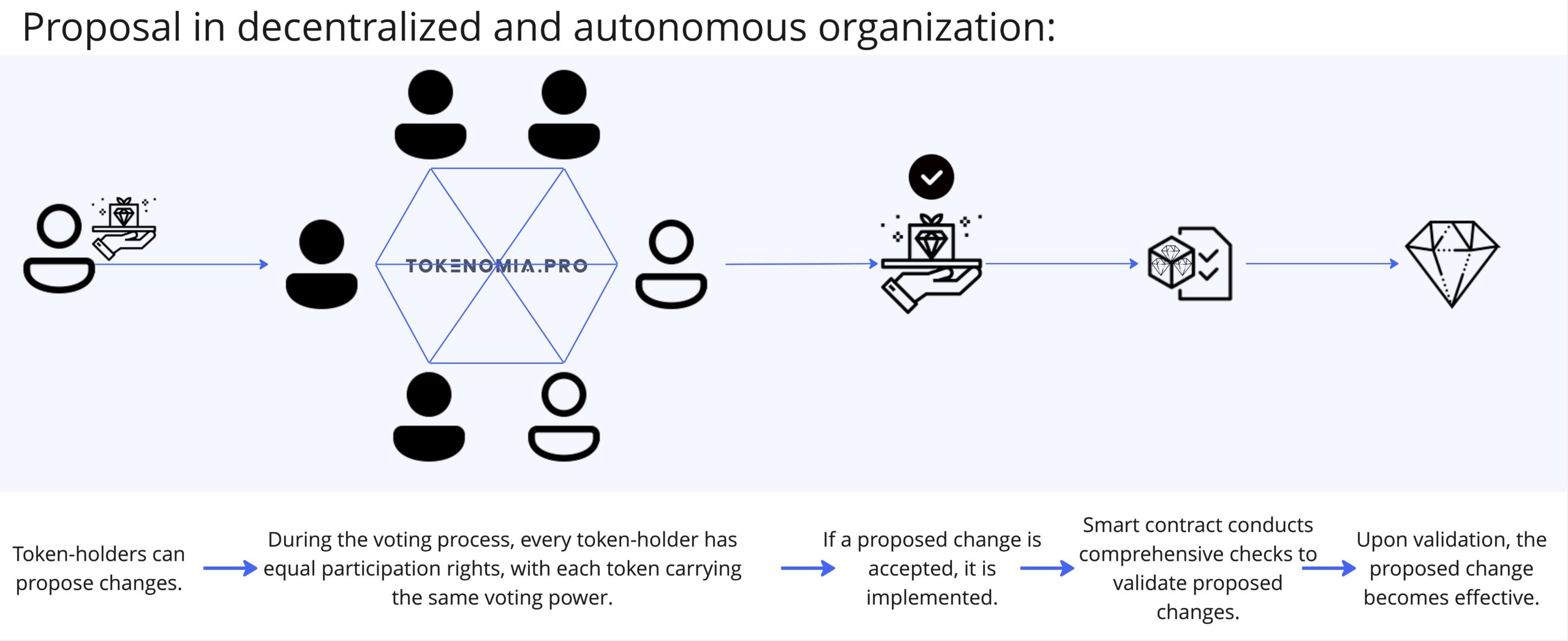
In DAOs, each user holds a specific number of tokens, which determine their voting power relative to the total available tokens and the method for calculating vote weight. To prevent monopolization, well-structured projects implement properly developed measures. This ability to propose and vote on initiatives as a token holder is the primary utility of DAO tokens, making them highly sought after. However, this is a broad topic that is discussed in more detail with examples later.
What is the role of the community in DAO?
Creators of Web3 projects may opt for DAOs for various reasons, the most popular being to motivate active community involvement. Crucial to this dynamic is the establishment of a well-conceived reward system and incentives. Participants in the DAO voting process may receive rewards, fostering ongoing engagement.
The decentralized structure eradicates favoritism, voting based on personal connections, or the lack of objectivity often encountered in traditional organizations. This setup promotes diverse opinions and allows the organization to include well-qualified specialists who may not be available for full-time positions.
For most participants in a DAO, the primary benefit of holding tokens lies in the decision-making power within the project. However, holders can also potentially profit by making astute investment decisions. Some DAOs can invest in assets approved by their members through voting. These assets include companies, NFTs, or other tokens. By making prudent decisions and augmenting the project’s overall value, contributors help ensure the success of the DAO.
What are the topics of voting and the applications of DAOs in Web3 projects?
DAOs enable voting on various project facets. Starting with airdrops to alterations in tokenomics and the management of physical assets. It can include resource allocation, protocol upgrades, governance proposals, asset management, partnerships, community initiatives and other new features.
Voting often revolves around solutions that can divide the community. In such cases, DAO allows for shifting responsibility away from the team. Voting topics may be limited to avoid decisions harmful to the system, such as when a single user receives a large number of tokens for themselves and exits the system. In other cases, the scope of voting topics is limited only by the creativity of the team and community.
While some projects are solely focused on DAOs, they can also be integrated as aspects of larger projects. DAO projects are diverse, addressing not only project-related matters but also real-world solutions. It’s worth noting that not every Web3 project incorporates a DAO, as it may not be necessary for every project’s objectives. While commonly associated with cryptocurrency realms, DAOs possess the potential to extend into diverse organizational models in the future.
The process of building Decentralized Autonomous Organizations
The process for implementing a DAO
It’s important to understand that DAOs come in many forms, each with different goals. Some focus on investments in DeFi, while others are community-driven DAOs supporting creative projects and initiatives. Regardless of the type, the use of governance tokens are key. They help raise money and create a decentralised way of funding the DAO.
Soliciting second opinions can be crucial in DAO creation. This could involve engaging with the community to spark interest and gain publicity, or consulting experienced individuals. Those groups can provide valuable insights into the economic or technical aspects of your idea. External input is especially helpful during crises, creative exhaustion, key decision-making, or when lacking specialized knowledge of the Web3 space.
Context and utility is a key
When outlining the process of building a project with a DAO, we always begin with the project idea and the intended utilization of the DAO. While the specifics will vary from one project to another, the first crucial step is to clearly define the purpose of the DAO and thecontext in which it will be embedded. This foundational decision sets the framework for the entire project.
For instance, the DAO might be designed to function as a DeFi tool, where it makes decisions regarding decentralized financial services, or it could be integrated into a gaming environment to enhance user engagement and in-game economies. Understanding this context is vital as it influences all subsequent decisions, particularly those related to the token’s economy.
A well-defined context helps in shaping the tokenomics of the project, determining how tokens will be distributed, utilized, and valued within the ecosystem. This contextual clarity ensures that the tokenomics model aligns with the project’s goals and user base, leading to a more robust and effective DAO.
For more detailed information on how different contexts affect tokenomics, you can read Tokenomics Explained – Tokenomics Depends on the context
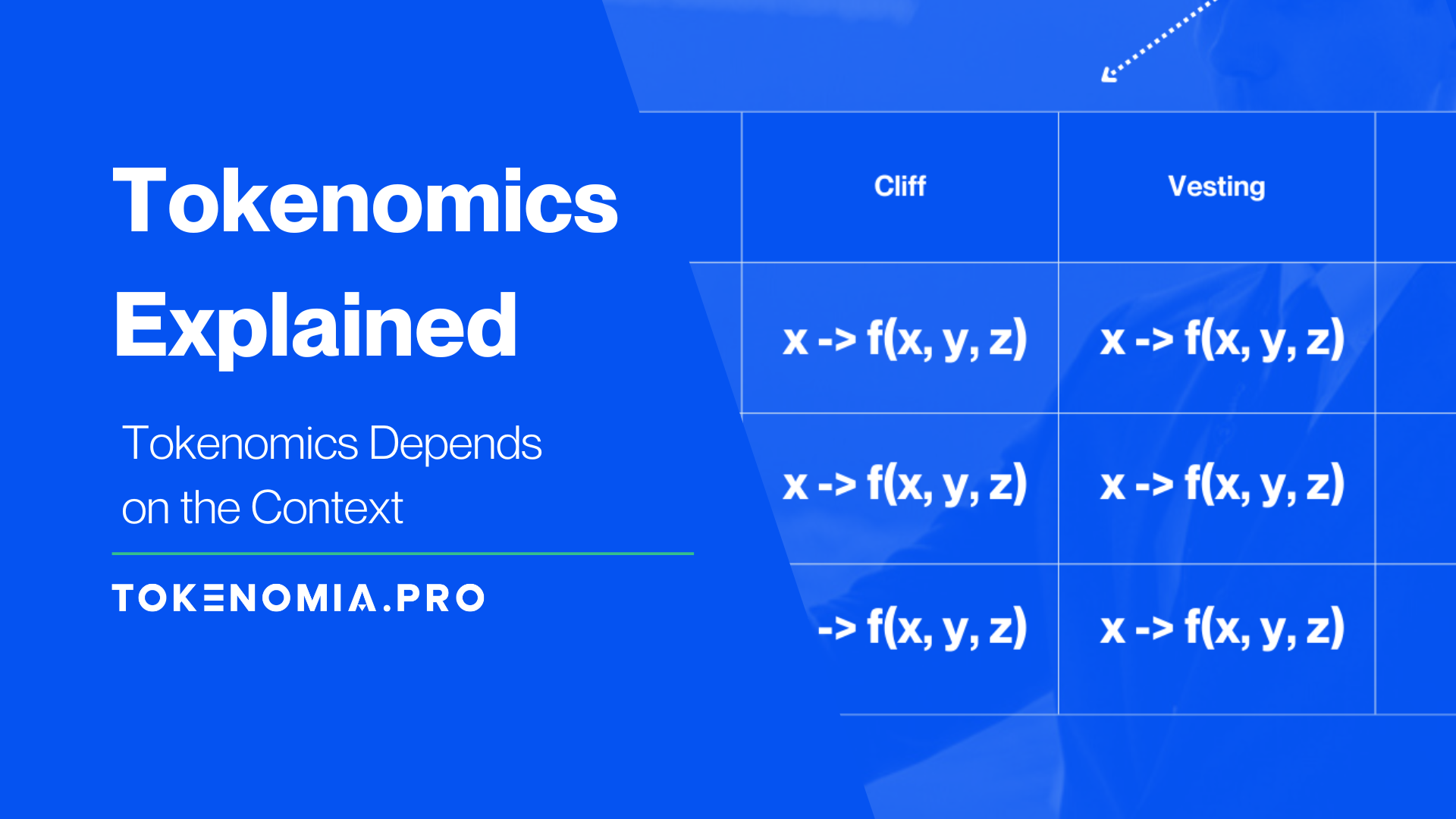
Tokenomics Explained – Tokenomics Depends on the context
Defining and understanding the goals of the project will also guide the choice of the environment, meaning the network on which we want to host our project. It is vital to ensure that the platform meets the project’s requirements for security, scalability, and community support. For example, if the project requires frequent voting, choosing a network with a big exchange commission would be an uneconomical solution.
Technical implementation and smart contracts
Next, we can proceed to the stage of technical implementation. This involves designing the functionality of the DAO based on the previously defined goals. The DAO’s economic design entails defining the operational rules and the mathematics underlying the project.
Smart contracts serve as the backbone of the entire DAO framework, they integrate conditions and rules encoded that govern various aspects of the DAO’s functionality. From establishing protocols for decision-making processes to outlining voting mechanisms and defining token distribution models. Every crucial aspect of DAO operation is laid out within these smart contracts.
Smart contracts, residing securely on the blockchain, function as automatic self-executing programs. Smart contract executes predefined instructions when triggered by specific conditions or events. Their autonomous nature ensures that the DAO operates transparently, without the need for centralized oversight. Also, smart contracts are unchangeable once deployed. They provide a tamper-proof foundation for the DAO’s operations.
Creating a DAO is challenging due to its inherent complexity. Consequently, achieving success in this field remains a difficult endeavor for many projects. Implementing a DAO is not straightforward; in practice, most projects still struggle with the challenge of full decentralization and automation. Most DAOs have not reached high levels of advancement, and such automation entails numerous technical and organizational challenges.
Building community and launching the token
If you’ve already started communicating your ideas to the community the start of the project should proceed much more smoothly. The success of DAO projects, like other Web3 ventures, particularly depends on building an active and engaged social network. An active community helps the project gain popularity, secure initial funding, and avoid the cold start problem. Therefore, it is essential for long term success to create the right rewards to motivate community involvement.
Once the phase of DAO launched is finished, token holders gain access to the DAO’s functions. They can participate in its governance and decision-making processes, proposing initiatives, casting votes on proposals, and contributing to the collective management of the organization. The tokens act as the digital embodiment of ownership or membership within the DAO ecosystem. Each token encompasses a specific array of rights and privileges, including voting power and access to DAO resources. Because tokens are tradeable on cryptocurrency exchanges, the market is able to determine their value. If the project proves successful and functions effectively, the value of the tokens is likely to increase.
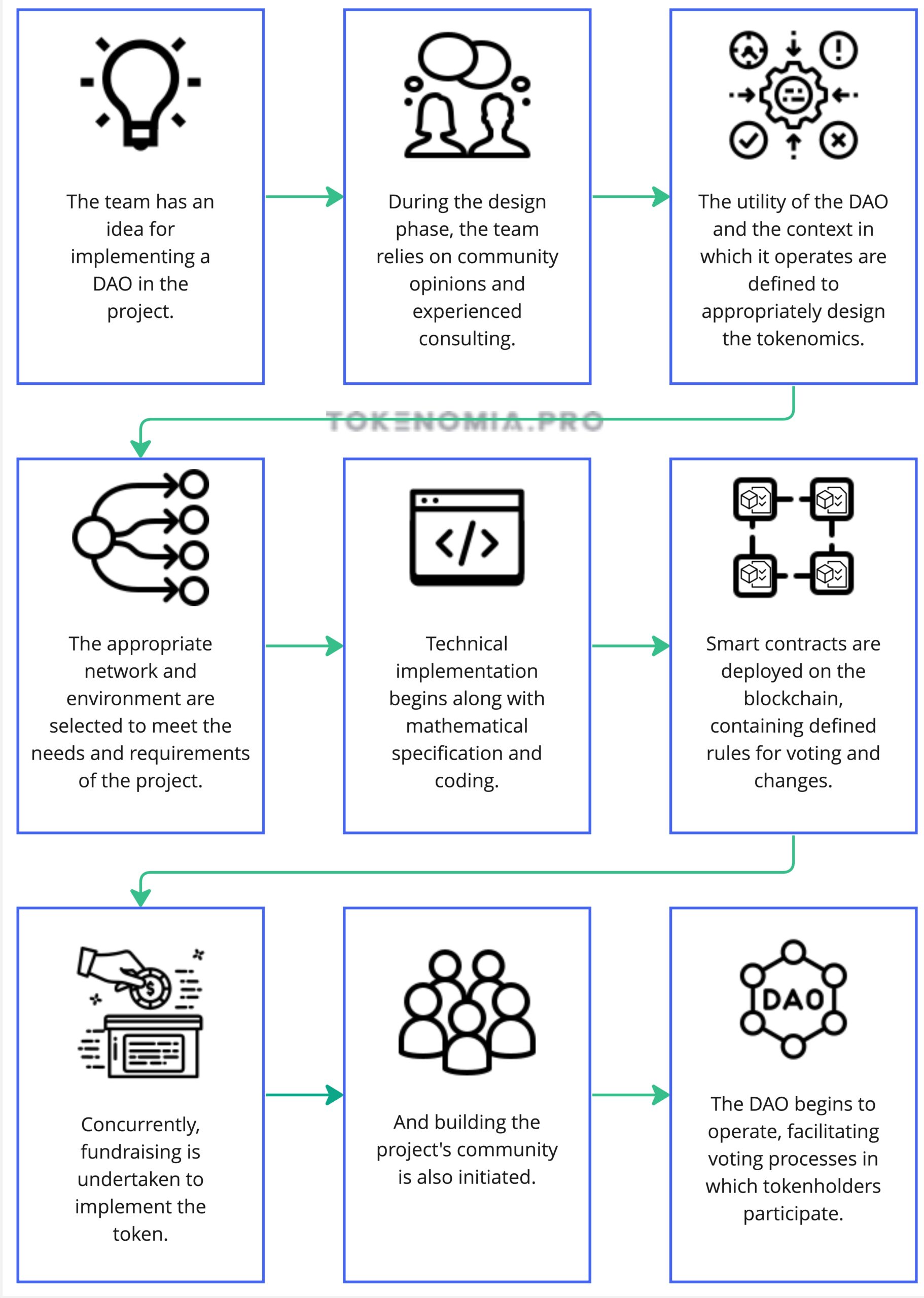
Empowering Solutions
The Main Advantages of Decentralized Solutions
Compared to classical management models, DAOs offer more flexibility and adaptability in implementing changes. A distinctive feature of the Web3 industry is the ability to develop a range of new solutions. This industry is growing extremely quickly and has no boundaries. Essentially, anything that is conceived can be implemented with the right technical support. Subsequently, the community decides whether the idea is viable and attractive to them. Consequently, DAOs possess numerous advantages that are challenging to achieve within classical structures.
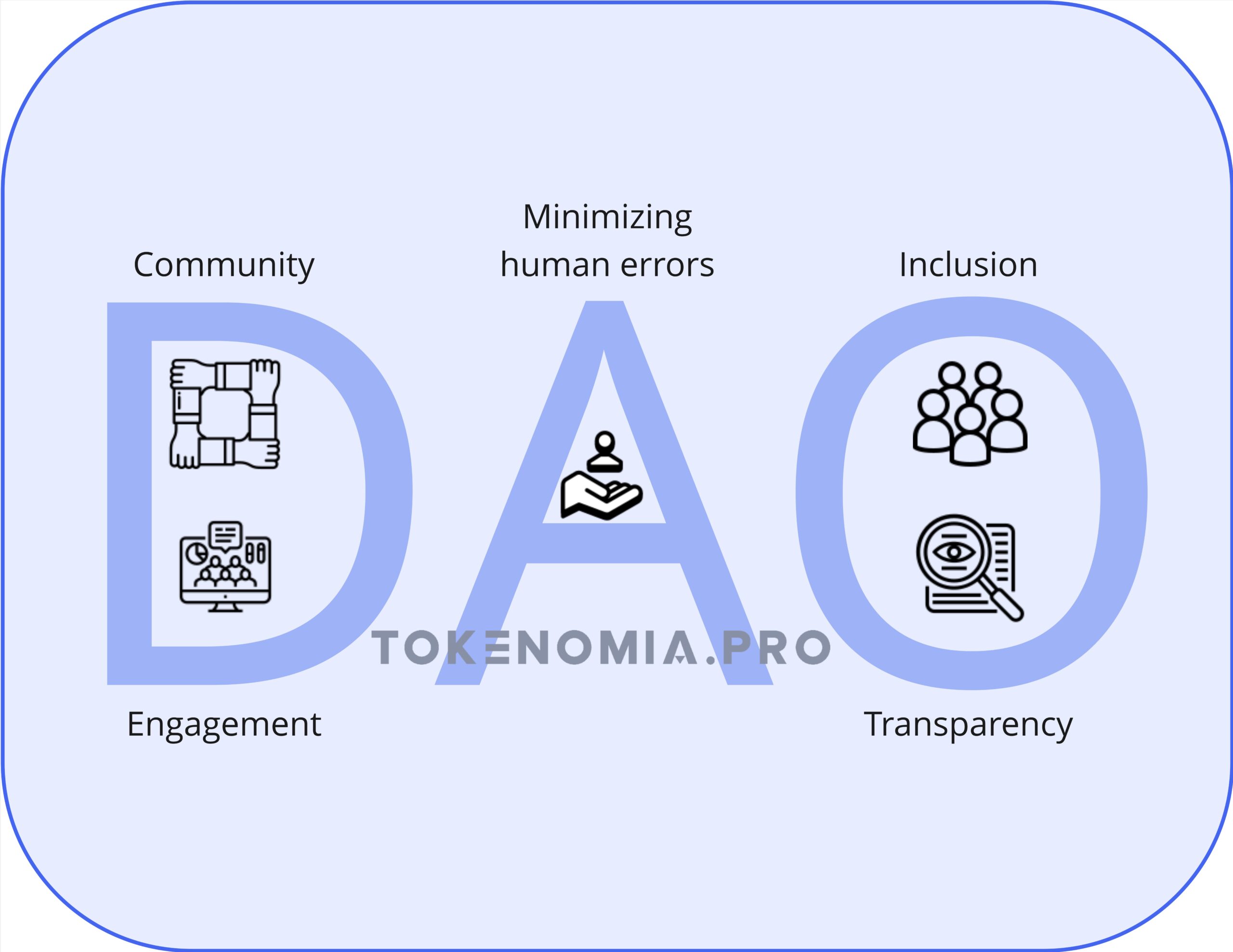
Inclusion:
One significant benefit of DAOs lies in their democratic nature. This means that people from all around the world can take part in important projects that have real financial effects. Getting involved in a DAO is easy; you just need to own a governance token and have access to the internet, making it open to anyone. In a truly decentralized DAO, decisions are made collectively by all members, preventing any single person from dominating control (provided the project is well-designed in terms of its economic structure). Also, this democratic setup ensures that every member can suggest projects or changes to the rules.
Engagement:
In DAOs, active participation is crucial for the smooth functioning of the group. This means that every member is not just welcomed but also given the power to share their thoughts by voting and taking part in making important decisions. Even though some members might possess a larger number of tokens, DAOs stress inclusivity by allowing all DAO holders to participate in voting and suggesting ideas. To ensure that holders are eager to take part in voting, it’s vital to establish enticing rewards for their involvement.
Transparency:
Transparency and publicity are fundamental principles. All activities are conducted via blockchain and made publicly viewable. This transparency is crucial because it holds members accountable for their actions. When all actions within the DAO are visible, it helps to prevent any bad behavior. It encourages members to make decisions that help the community and improve their reputation. Ultimately, this fosters an environment of trust and accountability in the organization.
Community:
Additionally, DAOs play a vital role in bringing people together to work towards a shared goal. They bring individuals from different backgrounds and places to collaborate on various projects. Everyone who holds tokens is not only financially but also personally invested in the project, which makes achieving success a joint effort. This mutual dedication creates a feeling of unity and support, encouraging active participation and improving the chances of the DAO’s achievements. This inclusiveness encourages a strong sense of responsibility and engagement among members. It strengthens the DAO’s common objectives and promotes a community-driven atmosphere.
Minimizing human errors:
Unlike traditional hierarchical organizations, DAO doesn’t have a central authority but use decision-making processes through smart contracts. This setup ensures fair governance and reduces the risk of one person having too much power, allowing the community to grow independently. In a traditional setting, proposals need to go through a board, causing delays and uncertainty. Also, personal biases and connections can affect voting outcomes. With DAOs, proposals are automatically implemented if they meet certain conditions set in a smart contract. To prevent a small group from taking over, DAOs use creative ways to calculate voting power. This keeps decision-making fair and in line with the community’s wishes.
Challenges of DAOs
What to Avoid When Designing a DAO?
While DAOs promise numerous potential benefits, they also come with their own set of challenges. It is important to keep this in mind when designing DAO projects, in order to minimize their risks and negative impacts. By being aware of these threats, we can appropriately address them within the project.
The method of calculating voting power:
The accumulation of voting rights tokens may lead to a concentration of power, potentially undermining the decentralized nature of the organization. According to a report by Chainalysis [https://www.chainalysis.com/blog/web3-daos-2022/], even if DAOs are meant to decentralize power, governance token data suggests that DAO ownership is highly concentrated. Across several major DAOs, less than 1% of all holders possess 90% of the voting power. Despite promoting transparency, DAOs typically operate with a flat organizational structure.
While some DAOs today might not fully stick to the decentralized ideals they promote, they can improve over time and become more decentralised. Their transparent decision-making is promising. But, it’s vital to figure out the best way to calculate voting power. This helps prevent any person or group from gaining too much control. Before launching the project, it’s crucial to simulate how votes and voting power are distributed to avoid monopolization and centralization.
In the Web3 world, projects have the flexibility to determine how the power of members vote is calculated, preventing monopolization and centralization of power. Various methods can be employed to calculate voting power, including linear, quadratic, and logarithmic approaches. There is also the possibility to apply a custom voting method tailored to the specific needs and dynamics of the project. These methods can be developed by the project creators or by companies specializing in token engineering.
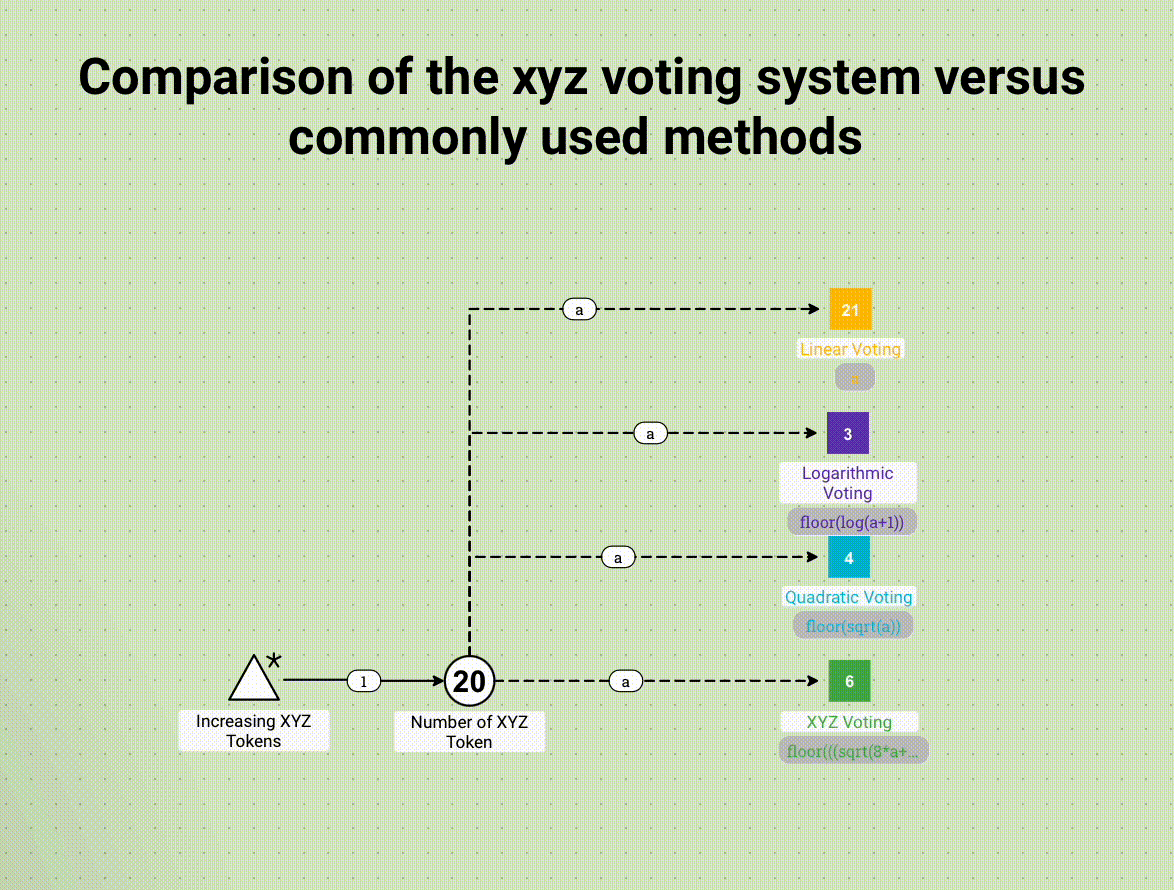
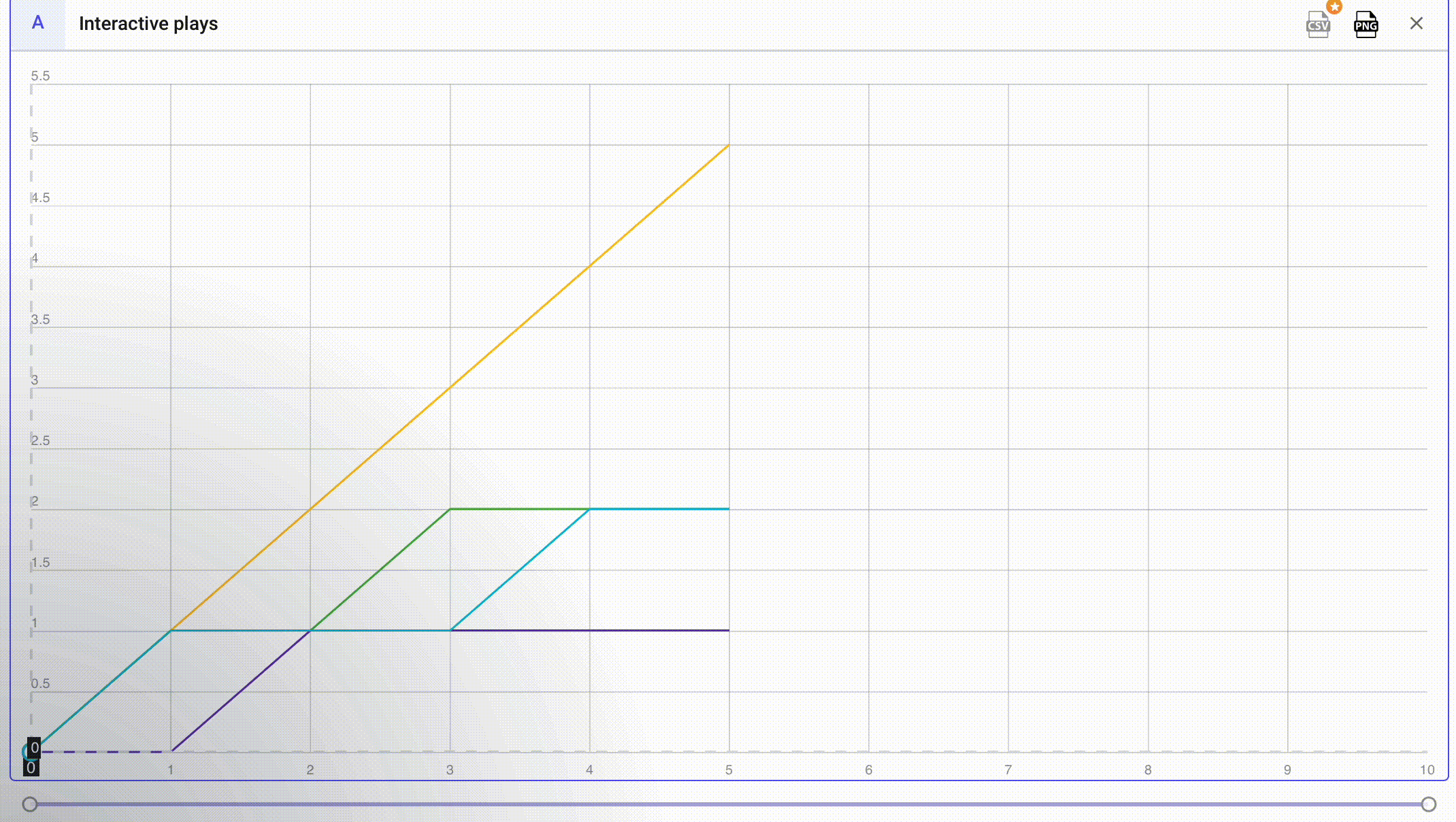
Those images illustrate different methods of calculating voting power, including our custom method developed for our client.
Note: At Tokenomia.pro, we conduct such simulations for our clients using a variety of tools, such as cadCAD in the Python environment.
Realistically balanced decentralization:
Finding a balance in incentives and rules is crucial here. If there are too many holders able to create proposals, the quality of proposals might decline, and the DAO could be overwhelmed with governance spam. Conversely, if too few holders have this ability, the community might doubt the authenticity of claims regarding “decentralized governance.”
Security in terms of the topic of voting is a major concern as well. DAOs must focus on security and protect themselves against potential exploits, which could drain much of their treasury. In these aspects, striking a balance between full decentralization and implementing rules to enhance and ensure the proper functioning of the system is crucial.
Maintaining open and effective communication with the community is crucial for DAOs. It is important to have regular interactions and ways to gather feedback from participants. This helps in making necessary adjustments to meet the needs of the community. Additionally, by promoting teamwork and responsibility, DAOs can establish a space where members feel encouraged to make valuable contributions while ensuring the system’s reliability.
Technical and economic security:
Technical and economic security are pivotal considerations for DAOs. Implementing and maintaining them requires significant technical expertise to minimize the possibility of hacking and other cybercrimes. Equally important are well-thought-out pools and mechanisms that prevent their exploitation, thereby ensuring the proper functioning of the system.
Quality of votes:
Similarly, education poses a challenge as DAOs must educate a diverse set of people regarding pending entity activity. With varying levels of education and experience, a DAO can suffer from poor decision-making due to a lack of expertise or bad actors
On the other hand, individuals interested in the project can contribute expert knowledge in their fields. But, this will only happen if our marketing reaches the target audience. Through this, we can gain valuable insights and expertise that we might not have had access to, due to limitations such as inability to hire them full-time or geographic constraints.
Conclusion
The idea of Decentralized Autonomous Organizations (DAOs) is truly exciting and innovative in how they manage organizations. These DAOs are built on core values like democracy, equality, and inclusivity. These values deeply connect with people and create a system that gives power to every person involved. Although DAOs offer numerous advantages, it’s crucial to highlight the essential contribution of a committed community around. Without a doubt, the success of any DAO relies heavily on the enthusiasm of its members, who steer its actions and operations towards success.
DAOs serve as a significant bridge between the tangible realities and digital landscape of Web3. By leveraging blockchain technology and smart contracts, DAOs offer a platform where individuals from diverse backgrounds can come together, collaborate, and co-create in a transparent and decentralized manner. This versatility extends their use beyond traditional structures. It makes them fit for a wide range of projects and initiatives.
An example of a thriving project that uses DAOs for numerous purposes is well known Ethereum blockchain. Also, the fact that the ten largest projects benefiting from DAOs have a combined market capitalization exceeding $31 billion [as of April 2024]. This clearly shows the importance of DAOs in web3. This significant value may suggest that there will be a growing trend towards using DAOs across different sectors.
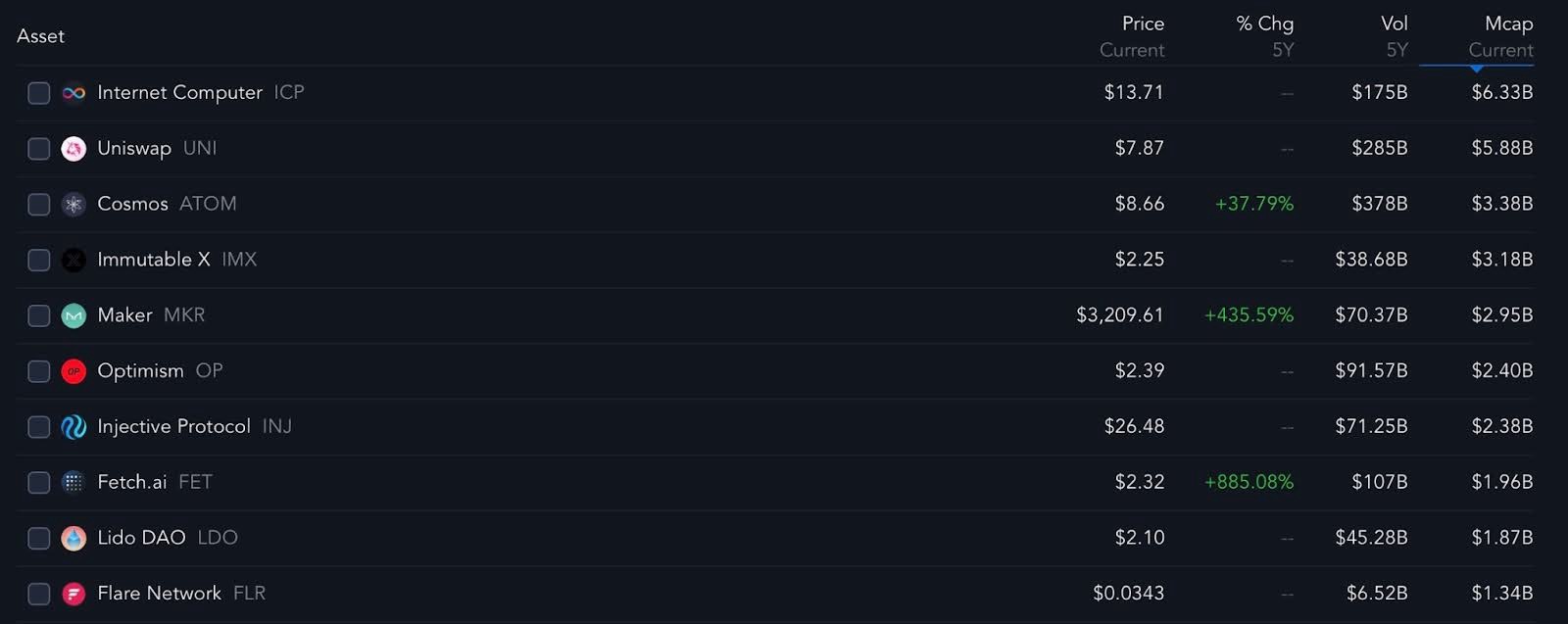
It’s likely that DAOs will continue to maintain or even increase their position in the coming years, as they reshape traditional organizational structures and promote decentralised decision-making processes.
Let’s look forward to exploring the potential of decentralised systems in the future. DAOs stand at the forefront, offering a glimpse into a world where collective empowerment and collaboration pave the way for transformative change.
In this article, you learned about:
- How does DAO empower the community?
DAO empowers the community by placing decision-making in their hands and encouraging collaboration through incentive mechanisms and investment opportunities. This setup motivates active participation and allows members to benefit financially from the project’s success.
- What is the process of building a DAO?
Building a DAO starts with defining its purpose and context, shaping its tokenomics to align with project goals. Next, choose a suitable network and implement smart contracts to automate operations. Secure funding and build a community to support the project. Once launched, tokenholders engage in governance and decision-making, benefiting from the project’s success. External opinions and community involvement are crucial for continuous development and success.
- What are the characteristics of DAOs?
Inclusion: Allowing anyone to participate and contribute to decision-making processes.
Engagement: Encouraging active involvement and collaboration from community members.
Transparency: Operating openly and transparently, with all actions and decisions visible to the community.
Community involvement: Empowering the community to shape the direction and governance of the organization.
Minimizing human errors: Leveraging smart contracts and automation to reduce the potential for human error in decision-making and execution processes.
- What are the biggest challenges of DAO projects and how can they be addressed?
- Finding the right method of calculating voting power
- Establishing realistically balanced incentives and principles
- Ensuring technical and economic security
- Enhancing the quality of votes
To tackle these challenges, we need thorough research, strong governance, and constant community communication. In addition to the right technical solutions, promoting clear and fair governance in the DAO ecosystem can reduce these challenges.
Let’s talk about DAO Economics Design
The best first step is to talk to our consultant. During a free consultation, you can check the consultant’s competences and look for initial solutions to the challenge that is currently most important for your project.
Let's Collaborate
Whether you have questions, collaboration ideas, or just want to say hello, we're here and ready to connect. Your inquiries are important to us, and we look forward to engaging in meaningful conversations.

